HOME
INTRO
SYMBOLS
ALMANAC
ECONOMY
GEOGRAPHY
STATE MAPS
PEOPLE
FORUM
NEWS
COOL SCHOOLS
STATE QUIZ
BOOK STORE
MARKETPLACE
STATE LINKS
GUESTBOOK
CONTACT US
| Report broken link | |
| All the presidents |


George Washington (1732-1799)
In Article II, Section 1 of the Constitution of the United States of America, the following requirements are stipulated for those wishing to hold the office of the President of the United States.
No person except a natural born Citizen, or a Citizen of the United States, at the time of the Adoption of this Constitution, shall be eligible to the Office of President; neither shall any Person be eligible to that Office who shall not have attained to the Age of thirty-five Years, and been fourteen Years a Resident within the United States.
1st President of the United States (1789-1797)
On April 30, 1789, George Washington, standing on the balcony of Federal Hall on Wall Street in New York, took his oath of office as the first President of the United States. "As the first of every thing, in our situation will serve to establish a Precedent," he wrote James Madison, "it is devoutly wished on my part, that these precedents may be fixed on true principles."
| George Washington: | |
|---|---|
| Source: University of Virginia, Miller Center of Public Affairs, www.millercenter.virginia.edu, March 8, 2006. | |
| 1st President of the United States | |
| Born: | February 22, 1732, Popes Creek, Virginia. |
| Nickname: | "Father of His Country" |
| Education: | Equivalent of an elementary school education. |
| Religion: | Episcopalian |
| Marriage: | January 6, 1759, to Martha Dandridge Custis (1731-1802) |
| Children: | None, although inherited two children of Martha Dandridge Custis when married: CHILDNAME and CHILDNAME. |
| Career: | Surveyor, Soldier, Planter |
| Political Party: | Federalist |
| President: | Two terms (eight years) from 1789-1797. |
| Age at inauguration: | 57 |
| Died: | December 14, 1799, Mount Vernon, Virginia. |
| Interred: | Family vault, Mount Vernon, Virginia. |
Born in 1732 into a Virginia planter family, he learned the morals, manners, and body of knowledge requisite for an 18th century Virginia gentleman.
He pursued two intertwined interests: military arts and western expansion. At 16 he helped survey Shenandoah lands for Thomas, Lord Fairfax. Commissioned a lieutenant colonel in 1754, he fought the first skirmishes of what grew into the French and Indian War. The next year, as an aide to Gen. Edward Braddock, he escaped injury although four bullets ripped his coat and two horses were shot from under him.
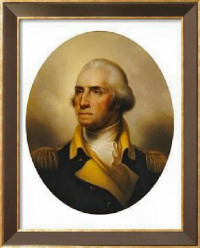 |
| George Washington by Rembrandt Peale
Smithsonian National Portrait Gallery Washington Prints |
From 1759 to the outbreak of the American Revolution, Washington managed his lands around Mount Vernon and served in the Virginia House of Burgesses. Married to a widow, Martha Dandridge Custis, he devoted himself to a busy and happy life. But like his fellow planters, Washington felt himself exploited by British merchants and hampered by British regulations. As the quarrel with the mother country grew acute, he moderately but firmly voiced his resistance to the restrictions.
When the Second Continental Congress assembled in Philadelphia in May 1775, Washington, one of the Virginia delegates, was elected Commander in Chief of the Continental Army. On July 3, 1775, at Cambridge, Massachusetts, he took command of his ill-trained troops and embarked upon a war that was to last six grueling years
He realized early that the best strategy was to harass the British. He reported to Congress, "we should on all Occasions avoid a general Action, or put anything to the Risqué, unless compelled by a necessity, into which we ought never to be drawn." Ensuing battles saw him fall back slowly, then strike unexpectedly. Finally in 1781 with the aid of French allies--he forced the surrender of Cornwallis at Yorktown.
Washington longed to retire to his fields at Mount Vernon. But he soon realized that the Nation under its Articles of Confederation was not functioning well, so he became a prime mover in the steps leading to the Constitutional Convention at Philadelphia in 1787. When the new Constitution was ratified, the Electoral College unanimously elected Washington President.
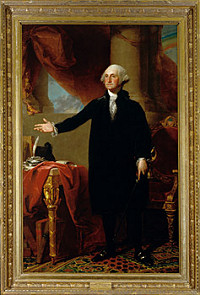 |
| George Washington by Gilbert Stuart
(Landsdowne Portrait) Smithsonian National Portrait Gallery Washington Prints |
He did not infringe upon the policy making powers that he felt the Constitution gave Congress. But the determination of foreign policy became preponderantly a Presidential concern. When the French Revolution led to a major war between France and England, Washington refused to accept entirely the recommendations of either his Secretary of State Thomas Jefferson, who was pro-French, or his Secretary of the Treasury Alexander Hamilton, who was pro-British. Rather, he insisted upon a neutral course until the United States could grow stronger.
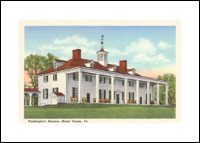 |
| Mount Vernon, Virginia
Mount Vernon Prints |
To his disappointment, two parties were developing by the end of his first term. Wearied of politics, feeling old, he retired at the end of his second. In his Farewell Address, he urged his countrymen to forswear excessive party spirit and geographical distinctions. In foreign affairs, he warned against long-term alliances.
Washington enjoyed less than three years of retirement at Mount Vernon before he died of a throat infection on December 14, 1799. For months the Nation mourned him.
Source: www.WhiteHouse.gov, March 9, 2007.
Presidential $1.00 coin:
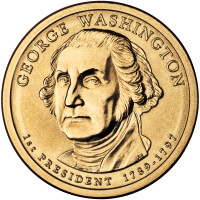 |
| U.S. Mint Image |
Following the ratification of the Constitution of the United States, the Electoral College unanimously elected George Washington to serve as the United States' first President.
The former General and Commander in Chief of the Continental Army served two terms as president, holding the office from 1789 to 1797.
On June 1, 1789, President George Washington signed the country's first Act of Congress, concerning the administration of oaths. In 1791, President Washington presided over the Nation's first recorded Cabinet meeting, which included Alexander Hamilton as the United States' first Secretary of the Treasury and Thomas Jefferson as the first Secretary of State.
President Washington himself laid the cornerstone for the United States Capitol building in Washington, D.C., on September 18, 1793.
Washington also laid the groundwork for the United States' earliest foreign policy stance when he issued his Declaration of Neutrality in 1793, a direct response to the emerging conflict between England and France.
Coinage Legislation under President George Washington
The Coinage Act of April 2, 1792: Commonly referred to as the Mint Act, this Act establishes the United States Mint at Philadelphia, the Nation's capital at the time. The Mint Act called for the production of the following coins, and specified their weight in gold, silver or copper: half-cent, cent, half-dime, dime, quarter-dollar, half-dollar, dollar, quarter-eagle ($2.50), half-eagle ($5.00), and eagle ($10).
Act of May 8, 1792: This Act authorizes the Director to purchase up to 150 tons of copper for the coining of cents and half-cents.
Act of January 14, 1793: This Act establishes the metal content of cents and half-cents.
Act of February 9, 1793: This Act establishes foreign exchange rates, and ends the acceptance of foreign coinage (with the exception of the Spanish milled dollar) as legal tender in the United States.
Act of March 3, 1794: This Act provides an accounting method of receiving metals for the purpose of producing coins from the metals received.
Act of March 3, 1795: This Act establishes the positions of melter and refiner of the United States Mint and grants the President the authority to reduce the amount of copper used in both the cent and half-cent.
United States Mint Directors appointed by President Washington
- 1792: David Rittenhouse, First Director of the United States Mint.
- 1795: Henry William de Saussure, Second Director of the United States Mint.
- 1795: Elias Boudinot, Third Director of the United States Mint.
Source: www.USMint.gov, March 9, 2007.
Additional resources:
George Washington America's Story from America's Library, the Library of Congress.
American Presidents: Life Portraits A Site to Complement C-SPAN's 20th Anniversary Television Series, American Presidents: Life Portraits.
George Washington (1732 - 1799) American President: An Online Reference Resource from the Miller Center of Public Affairs, University of Virginia. In-depth information reviewed by prominent scholars on each President and administration.
Rediscovering George Washington Companion site for Manifold Productions' Rediscovering George Washington discusses three character traits which allowed him to gain and wield power-skill as a warrior, charisma, and political savvy - and three traits which taught him to use it justly and to give it up-devotion to right ideas, civility, and magnanimous renunciation.
George Washington George Washington from Wikipedia, the free encyclopedia.
George Washington Papers at the Library of Congress The online version of the George Washington Papers at the Library of Congress offers access to the complete collection from the Library's Manuscript Division. This consists of approximately 65,000 items (152, 000 pages). Correspondence, letterbooks, commonplace books, diaries and journals, reports, notes, financial account books, and military papers accumulated by George Washington from 1741 through 1799 are organized into 8 Series.
Presidential Inaugurations: George Washington's first inauguration Presidential Inaugurations is presented by the Library of Congress, and other governmental departments, in collaboration with the Avalon Project at the Yale Law School. This presentation includes diaries and letters of presidents and of those who witnessed inaugurations, handwritten drafts of inaugural addresses, broadsides, inaugural tickets and programs, prints, photographs, and sheet music.
Presidential Inaugurations: George Washington's second inauguration Presidential Inaugurations is presented by the Library of Congress, and other governmental departments, in collaboration with the Avalon Project at the Yale Law School.
The Papers of George Washington from the Alderman Library, University of Virginia.
Washington at Valley Forge The story of Valley Forge can be understood only once you have met and recognized George Washington's extraordinary leadership abilities. The Valley Forge Historical Society.
George Washington: A National Treasure exhibition is a historic tour from the Smithsonian's National Portrait Gallery, celebrating our nation's first president - the man, the icon, the hero. As Gilbert Stuart's George Washington Lansdowne portrait travels across the country for the first time, Americans of all ages will be able to experience the most important visual document of our nation's founding. This Web site encourages visitors to learn about the enduring legacy of George Washington and gain an understanding of art history through the exploration of interactive portraits. The site also includes educational activities, and a forum for visitors to exchange ideas.
George Washington's Mount Vernon Estate and Gardens The estate, gardens and farm of Mount Vernon totaled some 8,000 acres in the 18th century. Today, roughly 500 acres of this historic estate have been preserved 16 miles south of Washington, D.C., on the banks of the Potomac River. Visitors can see 20 structures and 50 acres of gardens as they existed in 1799. The estate also includes a museum, the tombs of George and Martha Washington, Washington's greenhouse, an outdoor exhibit devoted to American agriculture as practiced by Washington, the nation's most important memorial to the accomplishments of 18th-century slaves, and a collection which features numerous decorative and domestic artifacts.
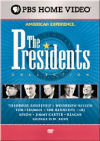
The Presidents
Collection DVD
His Excellency: George Washington,
by Joseph J. Ellis, 352 pages, Faber & Faber Ltd (August 30, 2005).
George Washington: Volume 1,
by James Thomas Flexner, 390 pages, Little, Brown and Company (August 1, 2006).
George Washington: Volume 2,
by James Thomas Flexner, Little, Brown and Company (1968).
George Washington: Volume 3,
by James Thomas Flexner, Little Brown and Company; 1st edition (1970).
George Washington: Volume 4,
by James Thomas Flexner, 554 pages, Little, Brown and Company; [1st ed.] edition (November 30, 1972).
George Washington: Leather-bound editions,
by James Thomas Flexner.
Washington: The Indispensable Man,
by James Thomas Flexner, 448 pages, Back Bay Books; Reissue edition (February 22, 1994).
More George Washington Books
from Amazon.com.
George Washington
on DVD from Amazon.com.
Site designed exclusively for NETSTATE.COM by NSTATE, LLC

NETSTATE.COM is a Trademark of NSTATE, LLC.
Copyright © by NSTATE, LLC. All rights reserved.
No copyright is claimed on non-original or licensed material.
Support NETSTATE

